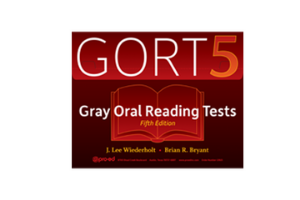Author:
J. Lee Wiederholt, Brian R. Bryant
Overview:
Screen and diagnose reading fluency
Age Range:
6:0 through 23:11
Administration:
Individual
Scoring Option:
Manual scoring
RTI Tiers:
RTI Levels 2 and 3
Testing Time:
20-30 minutes
The Gray Oral Reading Tests, now in its fifth edition, is one of the most widely used measures of oral reading fluency and comprehension in the United States. The GORT-5 has two equivalent forms, Form A and Form B. Each form contains 16 developmentally sequenced reading passages with five comprehension questions each. An optional miscue analysis system allows reading specialists to analyze reading errors and tailor interventions to specific students’ needs.
Features & Benefits
- New normative data were collected in 2008-2010
- Norms were extended upward to age 23 years, 11 months’
- Basal and ceiling rules were streamlined to make administration easier and more efficient
- Comprehension questions were completely revised, and studies were provided to show that the items are passage dependent
- Reliability and validity studies were added
- The overall look of the test was updated
Users & Applications
- Identifying students with reading difficulties. The GORT-5 can be used in identifying students who may need more intensive or explicit instruction in reading in order to make adequate progress in reading facility and/or comprehension.
- Diagnosing reading disabilities. The test can be used as part of a battery of tests for diagnosis of specific reading disabilities in children through young adults.
- Determining strengths and weaknesses. The GORT-5 can be used to compare intra-individual reading skills (e.g., reading rate vs. comprehension) and to help tailor interventions to the student’s specific needs.
- Evaluating students’ progress in reading. Having two equivalent forms enables examiners to conduct pre-and post-intervention testing to measure progress.
- Conducting research. The GORT-5 is a standardized, norm-referenced test, making it suitable for use in reading research.
Content & Administration
- Rate. The Rate Score is derived from the amount of time in seconds taken by a student to read a story aloud.
- Accuracy. The Accuracy Score is derived from the number of words the student pronounces correctly when reading the passage.
- Fluency. The Fluency Score is a combination of the student’s Rate and Accuracy Scores.
- Comprehension. The Comprehension Score is the number of questions about the stories that the student answers correctly. The open-ended format ensures that the items are passage dependent.
- Oral Reading Index. The Oral Reading Index is a composite score formed by combining students’ Fluency and Comprehension scaled scores.
Rate, Accuracy, Fluency, and Comprehension are reported as raw scores, grade and age equivalents, percentile ranks, and scaled scores having a mean of 10 and a standard deviation of 3. The Oral Reading Index is reported as a standard score based on a distribution having a mean of 100 and a standard deviation of 15. Percentile ranks are also provided.
Psychometric Information
- Rate, Accuracy, Fluency, and Comprehension are reported as raw scores, grade and age equivalents, percentile ranks, and scaled scores having a mean of 10 and a standard deviation of 3.
- The Oral Reading Index is reported as a standard score based on a distribution having a mean of 100 and a standard deviation of 15.
- Percentile ranks are also provided.
- Average internal consistency (content sampling) reliability coefficients exceed .90.
- The alternate forms reliability coefficients for the Oral Reading Index exceed .90. The average test-retest (time sampling) coefficients for the ORI for the same form (e.g., Form A to A, Form B to B) exceed .85.
- The average test-retest (time sampling) coefficient for the ORI for different forms (e.g., Form A to B and Form B to A) is .85.
- Correlations of the GORT-5 scores with those of other well-known reading measures are large or very large in magnitude.
- Binary classification studies indicate that the GORT-5 is able to accurately identify students with reading difficulties (i.e., sensitivity = .82, specificity = .86, ROC/AUC = .92, cut score = 90, low false positives).
- Considerable other validity evidence is provided in the manual.
GORT-5 Kit Contents
The complete GORT-5 Kit Includes: Examiner’s Manual, Student Book, and 25 Examiner Record Booklets each for Forms A and B, all in a sturdy storage box. (©2012)
